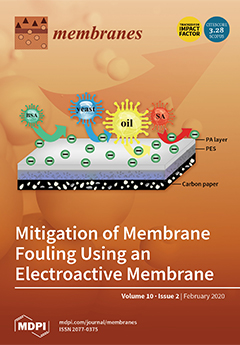For advanced water treatment, function of microfiltration (MF), adsorption, photo-oxidation, humic acid (HA), and polypropylene (PP) particles on membrane fouling and decay effectiveness were investigated in an integrated water treatment, of multichannel ceramic MF and PP particles, using UV radiation and air backwashing.
[...] Read more.
For advanced water treatment, function of microfiltration (MF), adsorption, photo-oxidation, humic acid (HA), and polypropylene (PP) particles on membrane fouling and decay effectiveness were investigated in an integrated water treatment, of multichannel ceramic MF and PP particles, using UV radiation and air backwashing. The synthetic feed was organized with HA and kaolin. The membrane fouling resistance (R
f) of the (MF + PP) system presented the lowermost, and amplified intensely from the (MF + UV) to MF system. The percentages of MF and adsorption by PP particles for turbidity treatment were 87.6% and 3.8%, individually; however, the percentages of MF and adsorption by PP particles for dissolved organic matters (DOM) treatment were 27.9% and 5.0%, respectively. The decay effectiveness of turbidity presented the greatest 95.4% at HA of 10 mg/L; however, that of DOM increased as HA concentration ascended. The ultimate R
f after 180 min procedure showed the maximum at 30 g/L of PP particles concentration, and improved dramatically, as PP particles decreased. Finally, the maximum V
T was acquired at 30 and 50 g/L of PP particles, because flux preserved greater throughout the procedure. The decay effectiveness of turbidity and DOM showed the maximal 95.4% and 56.8% at 40 and 50 g/L of PP particles, respectively.
Full article






